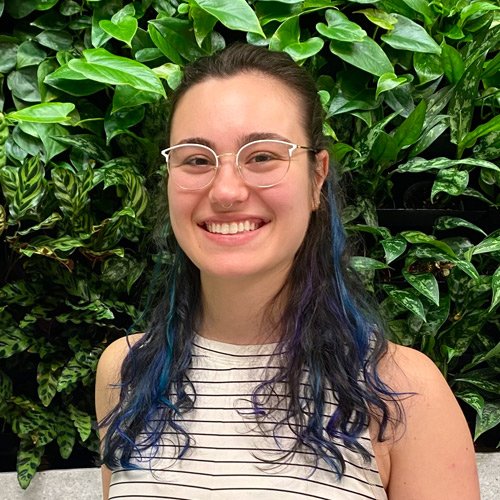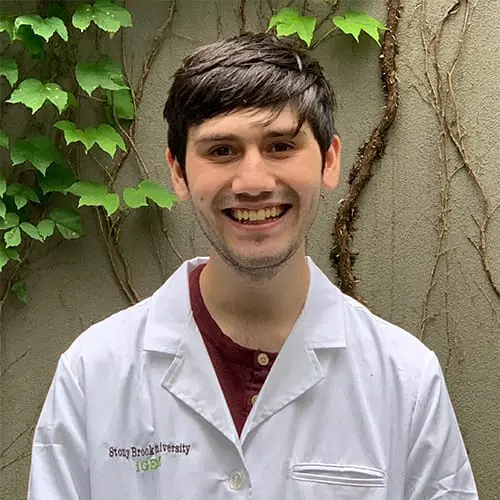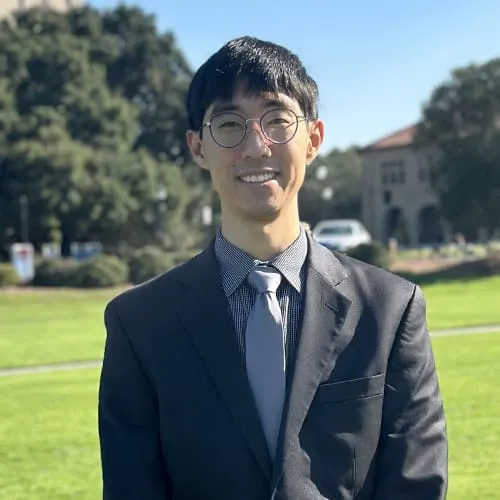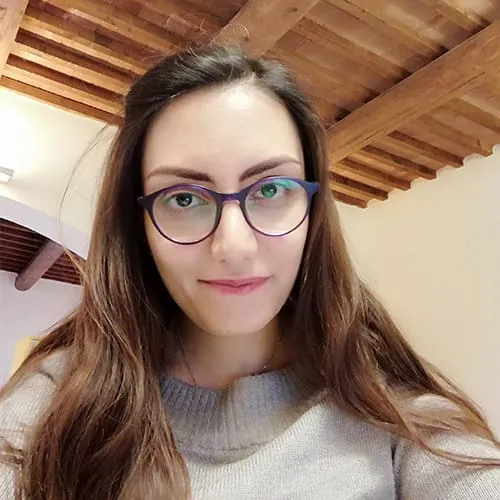


I grew up in a very small town in Northern New York, on the St. Lawrence River. During my undergraduate studies at the University of Rochester, I became interested in immunology, leading me to pursue a PhD at Columbia University in 2020. Ultimately, I decided to pursue research in hematopoiesis with the goal of understanding how blood production is drastically altered with aging, leading to immune susceptibility in the elderly.
My research project aims to understand the role of epigenetic drift in the dysregulated blood production that accompanies hematopoietic stem cell aging. By understanding how the epigenome changes across the lifespan, we hope to investigate whether modification of the epigenome in aged hematopoietic stem cells may restore youthful blood production.
Emmanuelle Passegué


My name is John Hobbs and I’m originally from Lonoke Arkansas. I grew to love research during my undergraduate honors project. Throughout the years, I learned that I enjoy utilizing state-of-the-art imaging techniques to understand cellular and molecular mechanisms of gene expression in relation to disease. I chose this career path because I enjoy learning about biological phenomena and dissecting the associated pathways.
As a PhD candidate, I am combining the live cell-single molecule imaging (Coleman laboratory) and hematopoietic stem cell biology expertise (Steidl laboratory) to elucidate how key hematopoietic transcription factors regulate blood cell development.
Dr. Robert Coleman and Dr. Ulrich Steidl
Ramnauth, A. D., Maynard, K. R., Kardian, A. S., Phan, B. N., Tippani, M., Rajpurohit, S., … & Martinowich, K. (2022). Induction of Bdnf from promoter I following electroconvulsive seizures contributes to structural plasticity in neurons of the piriform cortex. Brain Stimulation, 15(2), 427-433.
Maynard, K., Hobbs, J., Phan, B., Gupta, A., Rajpurohit, S., Williams, C., Rajpurohit, N., Shin, J., Jaffe, A., and Martinowich, K., (2018). “BDNF-TrkB signaling in oxytocin neurons contributes to maternal behavior.”
Maynard, K., Hobbs, J., Sukumar, M., Kardian, A., Jimenez, D., Schloesser, R., and Martinowich, K. (2018). “Electroconvulsive seizures influence dendritic spine morphology and BDNF expression in a neuroendocrine model of depression.” Brain Stimulation.
Maynard, K., Hobbs, J., Sukumar, M., Kardian, A., Jimenez, D., Schloesser, R., & Martinowich, K. (2017). “Bdnf mRNA splice variants differentially impact CA1 and CA3 dendrite complexity and spine morphology in the hippocampus.” Brain Structure Function.


I grew up in Long Island, and I am pursuing a PhD in biomedical engineering. I was always interested in the “why” of how something worked, so research was a natural step for me.
Benign prostatic hyperplasia (BPH) is characterized by an increase of growth in epithelial cells due to nonmalignant proliferation. By combining synthetic biology approaches with computational modeling, I aim to uncover predictive explanations of BPH pathogenesis and progression.
Dr. Gábor Balázsi


I am originally from Queens, NY and I chose the path of becoming a researcher because I realized my passion for scientific exploration during my undergraduate studies at SUNY Geneseo. I enjoy making new discoveries and feel my skills and efforts would be best put forth into research to make a beneficial impact in other people’s lives.
I am currently working on a new project focused on investigating the mechanisms through which PI3 kinase inactivation leads to impaired hematopoietic stem cell (HSC) differentiation and myelodysplasia. To examine this, I am studying how PI3 kinase inactivation regulates RNA splicing in HSCs, as well as characterizing a new conditional knockout mouse model of PI3 kinase in HSCs.
Dr. Kira Gritsman
Ramnauth, A. D., Maynard, K. R., Kardian, A. S., Phan, B. N., Tippani, M., Rajpurohit, S., … & Martinowich, K. (2022). Induction of Bdnf from promoter I following electroconvulsive seizures contributes to structural plasticity in neurons of the piriform cortex. Brain Stimulation, 15(2), 427-433.
Gurska LM, Okabe R, Schurer A, Tong MM, Soto M, Choi D, Ames K, Glushakow-Smith S, Montoya A, Tein E, Miles LA, Cheng H, Hankey-Giblin P, Levine RL, Goel S, Halmos B, Gritsman K. Crizotinib Has Preclinical Efficacy in Philadelphia-Negative Myeloproliferative Neoplasms. Clin Cancer Res. 2023 Mar 1;29(5):943-956. doi: 10.1158/1078-0432.CCR-22-1763. PMID: 36537918; PMCID: PMC9992133.
Maynard, K., Hobbs, J., Sukumar, M., Kardian, A., Jimenez, D., Schloesser, R., and Martinowich, K. (2018). “Electroconvulsive seizures influence dendritic spine morphology and BDNF expression in a neuroendocrine model of depression.” Brain Stimulation.
Maynard, K., Hobbs, J., Sukumar, M., Kardian, A., Jimenez, D., Schloesser, R., & Martinowich, K. (2017). “Bdnf mRNA splice variants differentially impact CA1 and CA3 dendrite complexity and spine morphology in the hippocampus.” Brain Structure Function.


I grew up in Delhi, India where I completed my schooling and undergrad degree. During my high school I learned about Mendelian inheritance and transcription of genes or, in other words, regulation of gene expression which was quiet intriguing. During the academic training for master’s, I developed a deeper understanding of the basic concepts in the field of genetics, molecular and cellular biology. What interested me was the concept that virtually all cells contain the same genetic material but not all genes are expressed in a given cell type owing to their epigenetic regulation.
My research focused on the characterization of antisense ncRNAs present during vertebrate development. We took a computational biology approach and analyzed pre-existing RNA-seq, CAGE-seq and ChIP-seq datasets to categorize the antisense – protein-coding pairs. My postdoctoral work involves building up on my knowledge of genetics and chromatin biology and addressing key questions relating to three-dimensional organization of the genome in the context of development.
Prof. James Bieker
Pillay S, Takahashi H, Carninci P, Kanhere A. Antisense RNAs during early vertebrate development are divided in groups with distinct features. Genome Res. 2021; 31(6):995-1010. Cited 9 times.
Ramilowski JA, Yip CW, Agrawal S, et al. Functional annotation of human long noncoding RNAs via molecular phenotyping. Genome Res. 2020;30(7):1060-1072. Cited 104 times
Chen X*, Pillay S*, Lohmann F and Bieker J. Association of Ddx5/p68 protein with the upstream erythroid enhancer element (EHS1) of the Klf1 gene. bioRxiv 743435; doi: https://doi.org/10.1101/743435. *co-first authors.


I grew up in the metro Detroit area and went to college and medical school in New York. I became interested in pediatric nephrology during medical school and developed a specific interest in the neonatal population during residency. I love that research allows me to try and improve the quality and standard of care that my patients receive.
My research involves using EMR data to look at the incidence of missed diagnoses of acute kidney injury in preterm infants admitted to the neonatal intensive care unit, identify clinical or demographic characteristics that may put patients at risk of having a missed diagnoses of AKI, and evaluate how clinical decision making is affected by the diagnosis of AKI.
Pamela Good, MD and Sumit Mohan, MD MPH


I am currently a pediatric nephrology fellow at Montefiore Medical Center. I am originally from Queens, NY and attended medical school at SUNY Downstate College of Medicine and completed my residency training at Rutgers Robert Wood Johnson University Hospital. My research is inspired by my patients and the goal of ultimately improving my patients’ quality of life is what drives me toward this career.
My current research is on the association of preterm birth with adverse outcomes of glomerular disease. This is examining how being born prematurely affects outcomes in patients who have disease in the glomeruli, or primary filters of their kidney.
Dr. Kimberly Reidy


Dr. Oh is from South Korea and completed his Master’s and Doctorate in Health Informatics at the University of Minnesota – Twin cities. He is passionate about uncovering meaningful patterns in data with clinical relevance. He enjoys collaborating with medical professionals to expand his understanding, and ultimately strives to develop treatment strategies that are optimal for providing better quality and cost-effective care to patients within the healthcare sector
The primary goal of this project is to develop reliable treatment bundles for sepsis-associated acute kidney injury (SA-AKI) by (a) developing and validating methodologies for early recognition of SA-AKI, and (b) employing causal inference techniques to ascertain subphenotypes and their corresponding treatment protocols, which mitigate the adverse effects of sepsis. This will facilitate the enhancement of individualized SA-AKI treatment bundles and advance our aim of fostering public health improvement within the United States.
Girish N Nadkarni, MD
G. Vasquez-Rios*, W. Oh*, S. Lee, P. Bhatraju, S. G. Mansour, D. G. Moledina, H. Thiessen-Philbrook, E. Siew, A. X. Garg, V. M. Chinchilli, J. S. Kaufman, C. Hsu, K. D. Liu, P. L. Kimmel, A. S. Go, M. M. Wurfel, J. Himmelfarb, C. R. Parikh, S. G. Coca, G. N. Nadkarni. Joint Modeling of Clinical and Biomarker Data in Acute Kidney Injury Defines Unique Subphenotypes with Differing Outcomes. Clinical Journal of the American Society of Nephrology, – Accepted.
W. Oh, M. S. Steinbach, M. R. Castro, K. A. Peterson, V. Kumar, P. J. Caraballo, G. J. Simon. A computational method for learning disease trajectories from partially observable EHR data. IEEE Journal of Biomedical and Health Informatics 2021;25(7)
W. Oh, G. N. Nadkarni. Federated Learning in Health care Using Structured Medical Data. Advances in Kidney Disease and Health 2023; 30 (1)


I grew up in Valley Stream, New York. I attended CUNY City College of New York where I received my bachelor’s degree in biophysics. I completed my doctoral studies in biomedical sciences from the Icahn School of Medicine at Mount Sinai. I chose a career in biomedical research because of the opportunity to use systems biology to improve patient care and health.
My research focuses on characterizing the cytoskeletal properties of differentiation in immortalized human podocytes cultured on biomimetic microfabricated surfaces. Our preliminary studies have shown that topographical cues from micropatterning promote an in vivo like morphology and improves cell differentiation. We are currently interested in exploring the functional differences of micropatterned podocytes and how this platform can be applied to identify nephrotoxic or protective compounds.
Dr. Evren Azeloglu
Stern, A. D., Smith, G. R., Santos, L. C., Sarmah, D., Zhang, X., Lu, X., … & Birtwistle, M. R. (2022). Relating individual cell division events to single-cell ERK and Akt activity time courses. Scientific Reports, 12(1), 18077 10.1016/j.neuron.2010.05.014.
Bouhaddou, M., Barrette, A. M., Stern, A. D., Koch, R. J., DiStefano, M. S., Riesel, E. A., … & Birtwistle, M. R. (2018). A mechanistic pan-cancer pathway model informed by multi-omics data interprets stochastic cell fate responses to drugs and mitogens. PLoS computational biology, 14(3), e1005985.
Stern, A. D., Rahman, A. H., & Birtwistle, M. R. (2017). Cell size assays for mass cytometry. Cytometry Part A, 91(1), 14-24.


I am a postdoctoral fellow in the lab of Dr. Sandeep Mallipattu at Stonybrook University. I was born in Moscow, in the former USSR, and came to the United States when I was 8 years old – after that living mostly in NYC and the tri-state area. I love research precisely because the failure rate is astronomically high, so it’s a challenge to come up with new questions and approaches to seemingly intractable problems. I chose biomedical research in particular because it keeps me grounded to the core ambition of this pursuit, which is to devise novel ways of tackling human disease pathogenesis.
Our group is focused on identifying the core molecular aberrations in proliferative glomerular diseases such as rapidly progressive glomerulonephritis (RPGN) and cellular/collapsing subtypes of focal segmental glomerulosclerosis (FSGS). Parietal epithelial cells that line Bowman’s capsule in the kidney glomerulus play a key part in disease pathogenesis and we are therefore committed to understanding their basal and disease-associated epigenomic and signaling cascades.
Dr. Sandeep Mallipattu
Cortes-Canteli M., Paul J., Norris E.H., Bronstein R., Ahn H.J., Zamolodchikov D., Bhuvanendran S., Fenz K.M., Strickland S. Fibrinogen and β-Amyloid association alters thrombosis and fibrinolysis: A possible contributing factor to Alzheimer’s disease. Neuron. 2010;66:695–709. doi: 10.1016/j.neuron.2010.05.014.
Gegenhuber B., Wu MV., Bronstein R., Tollkuhn, J. Gene regulation by gonadal hormone receptors underlies brain sex differences. Nature. 2022 Jun;606(7912):153-159.
Pace, J.*, Bronstein, R.*, Guo, Y., Yang, Y., Estrada, C., Gujarati, N., Salant, D., Haley, J., Bialkowska, A., Yang, V., He, J., and Mallipattu, S. Podocyte-specific KLF4 is required to maintain parietal epithelial cell quiescence in the kidney. Science Advances. 2021 10.1126/sciadv.abg6600 *These authors contributed equally.
Bronstein, R., Pace J, Gowthaman, Y., Salant, DJ., Mallipattu, SK. Podocyte-Parietal Epithelial Cell Interdependence in Glomerular Development and Disease. JASN. 2023 Feb 16. doi: 10.1681/ASN.0000000000000104. Epub ahead of print. PMID: 36800545. 10.1126/sciadv.abg6600 *These authors contributed equally.


I am Persian but I lived in aa beautiful city in Italy called Siena. I gained two Master’s degrees in nanotechnology and biotechnology and then PhD in medical Biotechnology during which I worked on designing vaccines. At a very young age I became deeply interested in science by joining summer schools in biology. I have always been interested in understanding mechanisms of diseases and hopefully to find prevention and treatments to diseases with no cure. I moved to United States in 2020 during Covid lockdown and I was fortunate to meet my PI and joined kidney research at Stony Brook Medicine!
There are currently no therapies available to slow or reverse AKI, which may also lead to fibrosis. During AKI, metabolic pathways become defective which leads to accumulation of substrates in the cell. Defective BCAA catabolism may cause PT cells injury in two possible ways, loss of cell energy source and activation of m-TORC1 signaling through accumulation of leucine. I am working on a way to activate BCAA metabolism so PT cells may be rescued from injury, to determine potential beneficial effects in AKI and fibrosis.
Dr. Sian Piret
Piret SE, Khan S, Fairuz F, Gholami S, Davis M, Kim CK, Espinoza M, Foster D, Kellum JA, Ahmad S, Kalogeropoulos AP, Mallipattu SK. Endotoxemia Correlates with Kidney Function and Length of Stay in Critically Ill Patients. Blood Purif. 2024;53(1):30-39. doi: 10.1159/000534107. Epub 2023 Nov 2. PMID: 37918364 10.1126/sciadv.abg6600 *These authors contributed equally.
Moscardini IF, Santoro F, Carraro M, Gerlini A, Fiorino F, Germoni C, Gholami S, Pettini E, Medaglini D, Iannelli F, Pozzi G. Immune Memory After Respiratory Infection With Streptococcus pneumoniae Is Revealed by in vitro Stimulation of Murine Splenocytes With Inactivated Pneumococcal Whole Cells: Evidence of Early Recall Responses by Transcriptomic Analysis. Front Cell Infect Microbiol. 2022 Jun 20;12:869763. doi: 10.3389/fcimb.2022.869763. PMID: 35795182; PMCID: PMC9251119
Gholami S, Goodarzvand Chegini K, Gheibi N, Mokhtarian K, Mohamadi M, Falak R. Cloning, expression, and spectral analysis of mouse betatrophin. Med J Islam Repub Iran. 2017 Dec 18;31:102. doi: 10.14196/mjiri.31.102. PMID: 29951403; PMCID: PMC6014755.
Gholami S, Gheibi N, Falak R, Goodarzvand Chegini K. Cloning, Expression, Purification and CD Analysis of Recombinant Human Betatrophin. Rep Biochem Mol Biol. 2018 Apr;6(2):158-163. PMID: 29765998; PMCID: PMC5941129.. Reports of Biochemistry & Molecular Biology, Vol.6, No.2, Apr
Mokhtarian K, Akhlaghi L, Meamar AR, Razmjou E, Manouchehri Naeini K, Gholami S, Najafi Samei M, Falak R. Serodiagnosis of fasciolosis by fast protein liquid chromatography-fractionated excretory/secretory antigens. Parasitol Res. 2016 Aug;115(8):2957-65. doi: 10.1007/s00436-016- 5049-7. Epub 2016 Apr 30. PMID: 27130320.